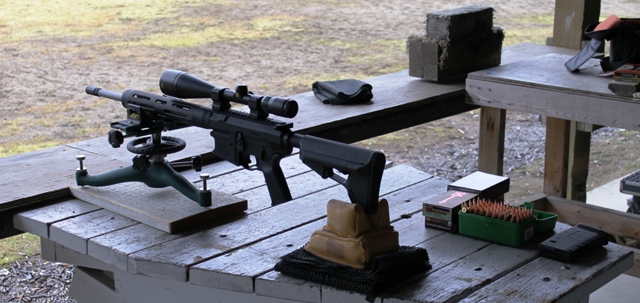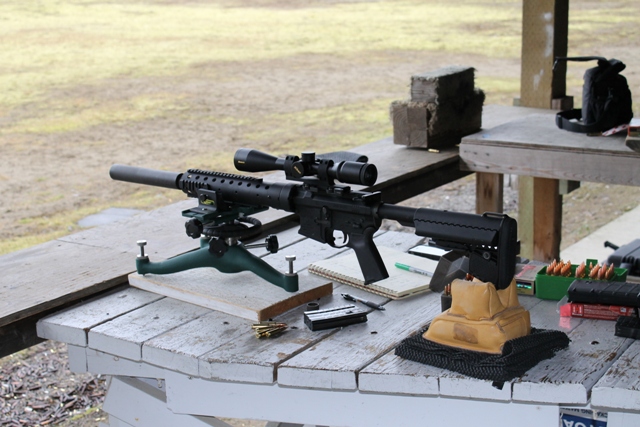
The latest grudge match in the tactical and sporting rifle world is heating up between two relatively new calibers: 6.8 SPC and the .300 AAC Blackout (“BLK”). We here at Bison Armory evaluated the BLK to see how it stacks up against the 6.8 SPC cartridge. We considered (1) what the BLK offers to the tactical rifle market and (2) whether it does anything better than the 6.8 SPC. Based on these criteria, we came to the conclusion that the BLK underperforms the 6.8 SPC where it really counts. And here’s why:
1. Parts Compatibility with .223 AR-15
Winner: 300 BLK
The 6.8 SPC and BLK both share good parts compatibility with .223 Rem / 5.56 NATO AR-15 rifles. Conversion to 6.8 SPC only requires the install of a caliber specific barrel, bolt, and magazine. BLK conversion, on the other hand, simply requires the install of a caliber specific barrel. Not only does this save a few bucks, but it means BLK rifles are PMag compatible. So the BLK takes this round.
2. Subsonic Rifle Operation
Winner: 6.8 SPC
Unlike the BLK, 6.8 SPC subsonic ammunition does not require both the use of a pistol length gas system and a silencer for your rifle to operate reliably with a 16″ barrel. With a 16″ barrel, 6.8 SPC subsonic ammunition loaded with 200 grain bullets will cycle and lockback the action with a carbine length gas system without a silencer. In high stress situations you want your rig to run whether or not you have a silencer attached. If something happens to your can, or for some other reason you cannot run suppressed, do you really want to be hand cycling your rifle in the heat of the moment? This is clearly an important win for the 6.8 SPC subsonic.
3. Subsonic Ammo Performance
Winner: 300 BLK
The 220 grain and 240 grain 300 BLK subsonics have 10% to 20% more muzzle energy, respectively, than the 200 grain 6.8 SPC subsonic at the muzzle. This is not a huge difference, but the BLK has the advantage.
4. Supersonic Ammo Performance
Winner: 6.8 SPC
Performance in this category is measured in terms of bullet velocity, energy, and drop as functions of range. We will compare the Sierra 115 grain Match King .277 for the 6.8 SPC with the Sierra 125 grain Match King .308 for the 300 BLK for an apples to apples comparison. Bullets are available for both rounds with higher BC’s and so forth, but to keep things simple we’ll work with the Sierra MK bullets. Ballistic coefficients are available directly from Sierra here. These are G1 ballistic coefficients and we’ll stick with that for sake of simplicity.
To start, the 115 SMK .277 has a ballistic coefficient of 0.317 for velocities between 1800 and 2400 fps, and the muzzle velocity of the round is assumed to be a relatively tame 2500 fps. The 6.8 SPC can be driven harder than this but, to be conservative, we’ll stick with 2500 fps out of a 16″ barrel.
The 125 SMK .308 has a ballistic coefficient of 0.338 between 2000 and 2650 fps and 0.330 below 2000 fps. For this comparison the higher BC will be used to give the BLK as much advantage as possible. The muzzle velocity from a 16″ barrel of 2215 fps direct from AAC will be used as well for this comparison.
The following chart shows the muzzle velocity from 0 to 500 yards using the Hornady Ballistics Calculator. 
Muzzle velocity by itself doesn’t say much about the performance of a cartridge, except that higher muzzle velocities tend to equate with flatter shooting. So next we will look at bullet drop vs range:

Both rounds are set to 100 yard zeros for comparison. There is not much difference between the trajectory of the two rounds until about 200 yards, at which point the difference in drop is only 2 inches. At 300 yards the difference is 6 inches, and at 400 yards the difference opens up to almost 13 inches. At 500 yards the difference is approximately 2 feet. The 6.8 SPC and 300 BLK are very similar to 300 yards, but past that the 6.8 is clearly superior in terms of bullet trajectory.
 Bullet energy is the best performance comparison of the three metrics considered here. The 6.8 SPC starts at the muzzle with 8.5% more energy than the 300 BLK. This advantage is maintained downrange to 300 yards, and the 6.8 SPC still has 3% more energy than the 300 BLK at 500 yards. Combined with the flatter shooting of the previous figure, which round are you going to want for 3-gun, hunting, or combat/tactical use?
Bullet energy is the best performance comparison of the three metrics considered here. The 6.8 SPC starts at the muzzle with 8.5% more energy than the 300 BLK. This advantage is maintained downrange to 300 yards, and the 6.8 SPC still has 3% more energy than the 300 BLK at 500 yards. Combined with the flatter shooting of the previous figure, which round are you going to want for 3-gun, hunting, or combat/tactical use?
The 6.8 SPC is the clear winner in this category. Who says you can trust my analysis? Apparently AAC does as they quoted my work on page 27 of this document.
5. Ammo Cost and Availability
Winner: Tie
Cost is more or less the same, and there are more varieties of 6.8 SPC available than 300 BLK on Midway USA. However, there is no commercially loaded 6.8 200 grain subsonic yet available, but there will be in the near future. So I call it a tie.
Overall Winner: The 6.8 SPC takes it.
While the 6.8 SPC and 300 BLK each win two of five categories with one category resulting in a tie, the 6.8 SPC won the title for best supersonic ammo performance. Supersonic ammo performance is, in my opinion, a more important category than the others, and where the 300 BLK had victories, the margins were narrow. Therefore the 6.8 SPC wins the grudge match in my opinion. Does this mean that the 300 BLK is a bad round, or that it isn’t an effective round for hunting, competition, or defense? Of course not. Both the 6.8 SPC and the 300 BLK outclass the 5.56 NATO in most categories, and both will serve their users well. Our goal is simply to cut through the hype.











